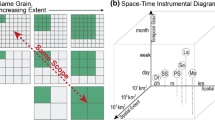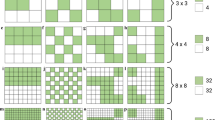Abstract
Enclosed, experimental ecosystems (“mesocosms”) are now widely used research tools in ecology. However, the small size, short duration and often simplified biological and physical complexity of mesocosm experiments raises questions about extrapolating results from these miniaturized ecosystems to nature. Dimensional analysis, a technique widely used in engineering to create scale models, employs “compensatory distortion” as a means of maintaining functional similarity in properties and relationships of interest. An earlier paper outlined a general approach to applying dimensional analysis to the construction and interpretation of mesocosm experiments (Petersen and Hastings in Am Nat 157:324, 2001). In this paper we use examples, largely drawn from the aquatic literature, to illustrate how dimensional approaches might be used to maintain key ecological properties. Such key properties include effective habitat size, environmental variability, vertical and horizontal gradients, and interactions among habitats. We distinguish both continuous and discrete approaches that can be used to achieve functional similarity through compensatory distortion. In addition to its potential as a tool for improving the realism of experimental ecosystems, the dimensional approach points towards new options for developing, testing and advancing our understanding of scaling relationships in nature.

Similar content being viewed by others
References
Adey WH, Loveland K (1991) Dynamic aquaria: building living ecosystems. Academic, San Diego
Bergström U, Englund G (2002) Estimating predation rates in experimental systems: scale- dependent effects of aggregative behavior. Oikos 97:251–259
Bergström U, Englund G (2004) Spatial scale, heterogeneity and functional response. J Anim Ecol 73:487–493
Carpenter SR (1999) Microcosm experiments have limited relevance for community and ecosystem ecology: reply. Ecology 80:1085–1088
Cohen JE, Tilman D (1996) Biosphere 2 and biodiversity: the lessons so far. Science 274:1150–1151
Cooke GD (1967) The pattern of autotrophic succession in laboratory microcosms. Bioscience 17: 717–721
Doering PH, Oviatt CA, Nowicki BL, Klos EG, Reed LW (1995) Phosphorus and nitrogen limitation of primary production in a simulated estuarine gradient. Mar Ecol-Prog Ser 124:271–287
Duarte CM, Maso M, Merino M (1992) The relationship between mesoscale phytoplankton heterogeneity and hydrographic variability. Deep-Sea Res 39:45–54
Englund G, Cooper SD (2003) Scale effects and extrapolation in ecological experiments. Adv Ecol Res 92:161–213
Enriquez S, Duarte CM, Sand-Jensen K, Nielsen SL (1996) Broad-scale comparison of photosynthetic rates across phototrophic organisms. Oecologia 108:197–206
Estrada M, Alcaraz M, Marrase C (1987) Effect of reversed light gradients on the phytoplankton composition in marine microcosms. Inv Pesq 51:443–458
Gervais F, Hintze T, Behrendt H (1999) An incubator for the simulation of a fluctuating light climate in studies of planktonic primary productivity. Int Rev Hydrobiol 84:49–60
Gieskes W, GW K, MA B (1979) Current 14C methods for measuring primary production: gross underestimates in oceanic water. Neth J Sea Res 13:58–78
Gilbert F, Gonzalez A, Evans-Freke I (1998) Corridors maintain species richness in the fragmented landscapes of a microecosystem. P Roy Soc Lond B Bio 265:577–582
Hastings A (1990) Spatial heterogeneity and ecological models. Ecology 71:426–42
Have A (1990) Microslides as microcosms for the study of ciliate communities. T Am Microsc Soc 109:129–140
Helms SE, Hunter MD (2005) Variation in plant quality and the population dynamics of herbivores: there is nothing average about aphids. Oecologia DOI 10.1007/s00442-005-0060-1
Hines AH, Whitlatch RB, Thrush SF, Hewitt JE, Cummings VJ, Dayton PK, Legendre P (1997) Nonlinear foraging response of a large marine predator to benthic prey: eagle ray pits and bivalves in a New Zealand sandflat. J Exp Mar Biol Ecol 216:191–210
Huffaker CB (1958) Experimental studies on predation: dispersion factors and predator–prey oscillations. Hilgardia 27: 343–383
Inouye BD (2005) Scaling up from local competition to regional coexistence across two scales of spatial heterogeneity: insect larvae in the fruits of Apeiba membranacea. Oecologia DOI 10.1007/s00442-005-0059-7
Ives AR, Foufopoulos J, Klopfer ED, Klug JL, Palmer TM (1996) Bottle or big-scale studies: how do we do ecology? Ecology 77:681–685
Kaiser H (1983) Small scale spatial heterogeneity influences predation success in an unexpected way: model experiments on the functional response of predatory mites (Acarina). Oecologia 56:249–256
Kareiva P (1989) Renewing the dialogue between theory and experiments in population ecology. In: Roughgarden J et al. (eds) Perspectives in ecological theory. Princeton University Press, Princeton, NJ, pp 68–88
Kemp WM, Lewis MR, Cunningham FF, Stevenson JC, Boynton WR (1980) Microcosms, macrophytes, and hierarchies: environmental research in the Chesapeake Bay. In: Giesy JP (ed) Microcosms in ecological research. National Technical Information Service, Springfield, pp 911–936
Langhaar HL (1951) Dimensional analysis and theory of models. Wiley, New York
Lawton JH (1995) Ecological experiments with model systems. Science 269:328–331
Lewis MR, Cullen JJ, Platt T (1984) Relationships between vertical mixing and photoadaptation of phytoplankton: similarity criteria. Mar Ecol-Progr Ser 15:141–149
Luckett C, Adey WH, Morrissey J, Spoon DM (1996) Coral reef mesocosms and microcosms—successes, problems and the future of laboratory models. Ecol Eng 6:57–72
Luckinbill LS (1973) Coexistence in laboratory populations of Paramecium aurelia and its predator Didinium nasutum. Ecology 54: 1320–1327
Margalef R (1967) Laboratory analogues of estuarine plankton systems. In: Lauff G (ed) Estuaries. American Association for the Advancement of Science, Washington, pp 515–521
Melbourne BA, Chesson P (2005) Scaling up population dynamics: integrating theory and data. Oecologia DOI 10.1007/s00442-005-0058-8
Naeem S, Li S (1997) Biodiversity enhances ecosystem reliability. Nature 390: 507–509
Naeem S, Li SB (1998) Consumer species richness and autotrophic biomass. Ecology 79:2603–2615
Nixon SW, Alonso D, Pilson MEQ, Buckley BA (1980) Turbulent mixing in aquatic mesocosms. In: Giesy JP (ed) Microcosms in ecological research. National Technical Information Service, Springfield, pp 818–849
Peeters JCH, Arts F, Escaravage V, Haas HA, de Jong JEA, van Loon R, Moest B, van der Put A (1993) Studies on light climate, mixing and reproducibility of ecosystem variables in mesocosms: consequences for the design. In: Peeters JCH et al.(eds) The impact of marine eutrophication on phytoplankton and benthic suspension feeders: results of a mesocosm pilot study. Eienst Getijde wateren, Middelburg, pp 7–23
Persson L (1991) Behavioral-response to predators reverses the outcome of competition between prey species. Behav Ecol Sociobiol 28:101–105
Peters RH (1983) The ecological implications of body size. Cambridge University Press, Cambridge
Petersen JE, Hastings A (2001) Dimensional approaches to scaling experimental ecosystems: designing mousetraps to catch elephants. Am Nat 157:324–333
Petersen JE, Kemp W, Bartelson R, Boynton W, Chen C-C, Cornwell J, Gardner R, Hinkle D, Houde E, Malone T, Mowitt W, Murray L, Sanford L, Stevenson J, Sundberg K, Suttles S (2003) Multiscale experiments in coastal ecology: improving realism and advancing theory. Bioscience 53:1181–1197
Rijkeboer M, Gons HJ, Kromkamp J (1993) Preservation of the light-field in turbid lake and river water in laboratory-scale enclosure. J Plankton Res 15:517–530
Sanford LP (1997) Turbulent mixing in experimental ecosystem studies. Mar Ecol-Prog Ser 161: 265–293
Schindler DW (1998) Replication versus realism: the need for ecosystem-scale experiments. Ecosystems 1: 323–334
Schmitz OJ (2005) Scaling from plot experiments to landscapes: studying grasshoppers to inform forest ecosystem management. Oecologia DOI 10.1007/s00442-005-0063-y
Sheldon RW, Prakash A, Sutcliffe WHJ (1972) The size distribution of particles in the ocean. Limnol Oceangr 17:323–340
Sugihara G, May RM (1990) Applications of fractals in ecology. Trends Ecol Evol 5:79–86
Thomas CD, Kunin WE (1999) The spatial structure of populations. J Anim Ecol 68:647–657
Turpin DH, Harrison PJ (1979) Limiting nutrient patchiness and its role in phytoplankton ecology. J Exp Mar Biol Ecol 39:151–166
West GB, Brown JH, Enquist BJ (1999) The fourth dimension of life: fractal geometry and allometric scaling of organisms. Science 284:1677–1679
Acknowledgements
John Petersen’s contributions to this work were funded by the U.S. EPA STAR program as part of the Multiscale Experimental Ecosystem Research Center (MEERC) at the University of Maryland Center for Environmental Science (Grant number R819640, Maryland U.S.A.). Travel funds were provided by Umeå University, Department of Ecology and Environmental Science (Umeå, Sweden). Many thanks to Allen Hastings, Michael Kemp and John Lawton for stimulating discussion that contributed to this paper.
Author information
Authors and Affiliations
Corresponding author
Additional information
Communicated by Craig Osenberg
Rights and permissions
About this article
Cite this article
Petersen, J.E., Englund, G. Dimensional approaches to designing better experimental ecosystems: a practitioners guide with examples. Oecologia 145, 215–223 (2005). https://doi.org/10.1007/s00442-005-0062-z
Received:
Accepted:
Published:
Issue Date:
DOI: https://doi.org/10.1007/s00442-005-0062-z




